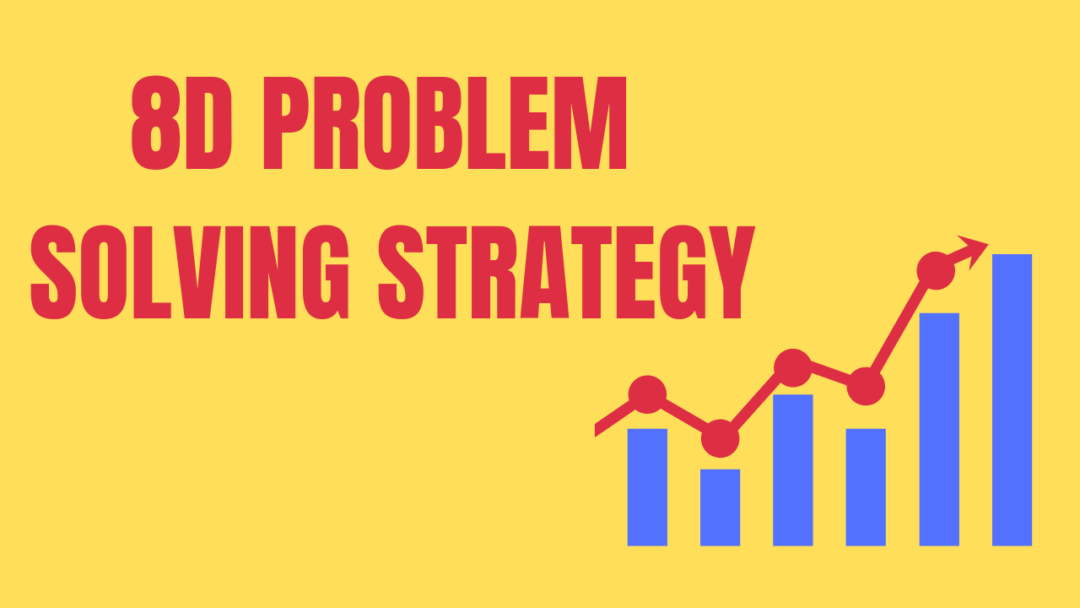This article explains the basics of 8D problem-solving process. You will be able to apply this tool to solve your problems, check their effectiveness and prevent their recurrence.
Table of Contents
What is 8D(Eight Disciplines)?
8D stands for eight disciplines (8D) model. It is a problem-solving approach typically employed in the automotive industry by quality engineers. But it has also been successfully applied in healthcare, retail, finance, government, and manufacturing.
8D is a problem-solving methodology, useful for finding a short term fix and permanent solution to your product or process problems.
It provides structure to the problem-solving process.8D methodology gives a hollistic approach to problem-solving. It covers containment till prevention of problem recurrence.
Moreover, this tool can be used as a part of continuous improvement of any product or process.
The purpose of the 8D methodology is to identify, correct, and eliminate recurring problems.
The 8D problem-solving model helps establish corrective and preventive action to avoid problems in the future.
ORIGIN
8D method was first used as a part of Team Oriented Problem Solving (TOPS) in the United States during world war-2.
8D Methodology was made popular by Ford in 1990s. It was used for all problem-solving activities. It helped standardize the problem-solving process throughout the automotive industry.
Although this method was originated by the US military, generally it is referred that Ford originated it, since they used it on such a large scale and made it popular.
The 8D method is also known as Global 8D, Ford 8D or TOPS 8D.
8D Methodology follows the PDCA approach.D1 to D5 is covered under the planning phase, D6- constitutes Do phase, D7 and D8 constitute check and act phase.
THINGS TO CHECK BEFORE IMPLEMENTING 8D METHODOLOGY
- Nature of the problem. Is it a new problem or a chronic one?
- Is it a repetitive problem? if yes what problem-solving methodology was used and why it failed?
- Checking the complete history of the problem.
8D PROBLEM-SOLVING METHODOLOGY
8D methodology consists of 8 steps or 8 Disciplines. It helps provide structure to our problem-solving process.
Due to its certain sequence, it helps inculcate multiple perspectives.
Also, this process helps back our actions with statistical data. The 8D Report consists of 8 disciplines that describe corrective measures based on the statistical analysis of the problem.
D1-Create a Team
Building a relevant team is the first step to this problem-solving process. The team should be multidisciplinary. It should include all departments like Production, Development, Quality, etc.
Combination of multiple experiences, skill set, and knowledge base helps take the multidimensional perspective of the problem in hand.
Somebody should be adopted as a team leader. Because the team without captain means, everybody is captain, which creates chaos and hampers the process.
Roles and desirable outputs of each member have to be clearly defined. It makes the process effective. Defining roles and expectation in advance makes the process quicker and more efficient.
Who should be on the 8D team?
The appropriate size of the 8D team is 4 to 8 people who are closely related to the problem. It usually involves people from different functions/departments in the organization coming together to solve a common problem.
- A champion is a sponsor, not an active working member. He is responsible for proving final approval for changes if he agrees with findings.
- A team leader (i.e. Quality engineering or Product Manager) – The person who coordinates the entire 8D project through-out all of its 8 disciplines. Team leader act’s as a binding force amongst all team members.
- An 8D expert (i.e. Quality Engineering) – A person who has the technical know-how of the 8 disciplines. He/she guides the team for appropriate implementation of 8D methodology.
- A subject expert is one who has the domain expertise.He/she is expert in the domain to which problem belongs. Example casting expert.
- Supporting Functions (i.e. Supplier Quality, Electrical Engineering, Mechanical Engineering, Manufacturing Engineering, Operations, Field Service, Technical Support, Marketing, Application Engineering, etc…) – people who have practically experienced the problem and understand the pain it causes.
Key responsibilities of team leader
- The team leader must define the roles of each team member and bring it on paper.
- The team leader must schedule meetings periodically to review the progress of the 8D project and discuss activities related to any delays. All meetings should be documented. Minutes of the meeting must include agenda, actions decided, responsibility, target date.
D2-Describe Problem
Well-defined problems lead to breakthrough solutions. Organizations need to become better at asking the right questions so that they tackle the right problems.
Define the problem as objectively as possible. A clear description of the problem helps the team come up with more relevant solutions.
Communicate the scope of the problem that the team is working on and get the team focused.
What to define at this stage
- Timeline.
- Monetary limits.
- Expectation and deliverables from the team.
Tools used at this stage
- Data collection for background information (is/is not analysis).
- Pareto charts.
D3-Containment Action
Containment action is like first aid. You try to avoid worsening of the wound. Containment action is like temporary action or a quick fix till team works on permanent action.
For example, if you receive a customer complaint in a particular part. Your first response would be to stop all supplies or production of that particular part. You would check all the material at the customer end, at your plant or in-transit for any defect.
It would not solve the issue permanently but would provide a temporary fix.
Why containment action is important
- Problem-solving is a time-consuming activity. Containment is important to avoid further production of defective parts and dispatch to the customer.
- Containment guarantees limitation of risk and warranty claims.
Check Points for this stage
- Effectiveness of containment action.
- Never allow an interim containment action to cover the gravity of the problem thus reducing the need for a permanent solution
- Additional problems are not generated by the implementation of containment actions.
- Relative cost benefits of containment actions should be tested.
D4 – Identify the root cause
Once the problem has been contained, the next step is to find out the root cause. Why it occurred?
Brainstorming sessions are arranged to find out all the possible causes. An important aspect of brainstorming is that no filters are there during brainstorming sessions.
Defining the root causes of a problem is the core of the 8D problem-solving process. This is normally the toughest aspect of the problem-solving process; if the root causes of the problem were obvious, then the problem would have been solved already.
Tools used at this stage
- Pareto Charts
- Affinity Diagram
- Brainstorming Session
- 5-Whys Process
- Fishbone Diagram
- Fault Tree Analysis
- Statistical Analysis
- Regression Analysis
- Hypothesis Testing
- GR&R
- Flow Charts
Check Points for this stage
- Root cause identified is not just a symptom. Make sure the symptom is not cured in the illusion of root cause.
- Make sure the root causes found fit both the “is” and the “isn’t” sections of the question.
- The root cause is simulated, to verify the effect.
D5 – Permanent corrective actions
Any problem can have multiple root causes. In this step, we provide permanent corrective actions for one or more root causes identified in the previous step.
Corrective action is an action to eliminate the cause of a detected nonconformity.
It’s important at this stage, to define what is the corrective action? When it has to be implemented? Who will implement it? Where to implement? How it would be implemented?
Defining what, when, who, where and how brings objectivity to this process. It keeps everyone involved accountable.
Criteria for choosing the best solution
- The solution is practical. The team should be able to implement it.
- It is feasible.
- The solution is cost-effective.
- It is robust. The solution shouldn’t fail when used in production. Robustness of the solution is an essential characteristic.
- Team champion agrees with it.
- The solution is first to be tried on small lots to validate that it has indeed solved the problem prior to full implementation.
Checkpoints for this stage
- Resources required for the implementation of the solution are easily available.
- Supplier capacity is sufficient to produce tighter specs if required.
- ROI(Return on investment) is positive.
- The solution can be implemented within the deadline.
- Training is provided.
D6 – Implement Permanent corrective actions
In this step, we implement the corrective actions derived in the previous step.
We implement corrective action and check its effectiveness. If action is not effective we repeat D4 and D5. The process repeats until the action taken is not effective.
The statistical tools such as process capability, histograms, control charts, etc. can be used to measure and verify the effectiveness of the implemented corrective actions.
Our goal at this step is to verify if actions taken are solving the problem effectively or not?
Checkpoints for this stage
- The action plan is laid out on paper. Tools like Gantt Chart, PERT can be used for planning.
- All procedures have been laid out for action implementation.
- Training is provided.

D7 – Prevent Recurrence
In this step, we take preventive measures to avoid recurrence of the problem. Prevention is better than cure, hence implementing systems which avoid recurrence of problems is an important aspect of the problem-solving process.
Preventing the problem from recurring requires analyzing design, operation, and management system in minute details.
We make changes in design(product or process), operation system and management system to avoid problem repetition.
We need to horizontally deploy actions to similar sections(Where ever applicable). It involves standardization of systems to incorporate changes as a part of the system.
Checkpoint for this stage
- Actions taken are validated.
- Action plan results are documented.
- Corresponding standard documents are updated.
- All controls for the solution are put in place.
Tools used at this stage
- Control charts
- Control plans
- Histogram
- Capability Analysis
- FMEA
D8 – Congratulate Team
Conducting this whole drill without the team is close to impossible. Once the process has been completed and results are available in measurable form.
We need to appreciate each member of the team for there efforts and reward them for their contribution.
Appreciating work of team members, instill a feeling of participation in team members and make them feel important. This kind of acts helps uplift team morale.
All the above seven steps won’t be sustainable without this last step. So its super-duper important.
WHY USE 8D METHODOLOGY?
8D Methodology has been popular amongst engineering teams as it provides a clear cut, easy to learn approach for problem-solving. It helps reach better solutions because of its inherent structured approach.
I have listed down benefit 8D methodology offers :
- It helps provide a structure for our problems solving process.
- Its has become a global standard, so everyone understands it well.
- It brings order to chaos.
- The fast and effective methodology of problems solving.
- It helps document the process.
- Instills a feeling of self-worth in the team due to active participation in the process.
- Defining steps in advance, avoid chances of skipping any part of the process.
- It is easy to learn and implement.
- Provides a practical understanding of Root cause analysis(RCA).
- Since it uses a team approach, multiple perspectives are taken into consideration before reaching a conclusion.
8D problem-solving tool not only helps solve current problems but also make us future-ready.
The following improvement tools are often used within the 8D methodology:
- Ishikawa diagrams (Cause and Effect diagrams, C&E diagrams or Fishbone diagrams)
- Pareto charts or Pareto diagrams
- 5 Why’s
- 5W and 2H (Who, What, Where, When, Why, How, How often)
- Statistical Process Control (SPC)
- Scatter plots or scatter diagrams
- Design of Experiments (DOE)
- Check sheets
- Histograms or Capability Analysis
- Failure Modes and Effects Analysis (FMEA)
- Flowcharts or Process Maps
WHEN TO USE 8D METHODOLOGY?
The 8D approach is used to solve critical, major, chronic and recurring problems.
The 8D use is typical when:
- The problem complexity exceeds the ability of one person (an expert) to resolve the problem.
- Communication of the problem resolution (during & after) must go across company levels, other departments and/or to customers. The same solution can be applied to multiple areas.
- The customer requests for submission of 8-D.
However, the 8D is not effective for
- Non-recurring problems or problems which can be solved quickly by individual effort.
- Problems with known root causes.
- To choose between different alternative
FOOD FOR THOUGHT
Look around you and find one problem statement where you can apply this methodology.
Share your experience and knowledge in the comments box below.
If you liked this article, then please share with your team members and friends.
Do let us know what we need to improve on, to make it a better experience for you. Help us serve you better.





Good post. I learn something totally new and
challenging on websites I stumbleupon on a daily basis.
It’s always useful to read articles from other authors and
use a little something from other websites.
Hi there, I enjoy reading all of your post. I like to write a little comment to support you.
Thanks for your Support!